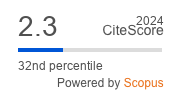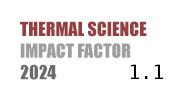THERMAL SCIENCE
International Scientific Journal
INVESTIGATING THE EFFECTS OF ISOBUTANOL-GASOLINE BLENDS ON EXHAUST EMISSIONS AND ENGINE PERFORMANCE IN A SPARK IGNITION ENGINE
ABSTRACT
This is the effects of isobutanol, which is an isomer of butanol, mixed in different ratios in gasoline fuel in a low-power single-cylinder spark ignition engine exhaust emissions on and engine performance according to engine load changes. The amount of isobutanol in the fuel compared to gasoline fuel reduced CO emissions. The addition of isobutanol reduced HC emissions for all engine loads. In addition, the formation of isobutanol accumulation in the fuel in the spark ignition engine significantly reduced NOx emissions compared to gasoline. For the highest engine load, NOx emissions decreased by 39.55% for I20 fuel compared to gasoline. An increase was shown compared to brake specific fuel consumption gasoline in all mixture ratios with the use of isobutanol. The minimum brake specific fuel consumption was obtained as 383.76 g/kWh at 5000 W load with the use of I0 fuel. The maximum brake thermal efficiency value was obtained at 5000 W with the use of I0 fuel.
KEYWORDS
PAPER SUBMITTED: 2024-12-15
PAPER REVISED: 2025-02-19
PAPER ACCEPTED: 2025-03-15
PUBLISHED ONLINE: 2025-09-26
THERMAL SCIENCE YEAR
2025, VOLUME
29, ISSUE
Issue 4, PAGES [2967 - 2975]
- Lee, Sunggyu., et al., Handbook of Alternative Fuel Technologies, CRC Press, Boka Raton, Fla, USA, 2007
- Awad, O. I., et al., Using Fusel Oil as a Blend in Gasoline to Improve SI Engine Efficiencies: A Comprehensive Review, Renewable and Sustainable Energy Reviews, 69 (2017), Oct., pp. 1232-1242
- Sun, S., et al., Vehicle Emissions in a Middle-Sized City of China: Current Status and Future Trends, Environ Int, 137 (2020), 105514
- Celik, M. B., Performance Improvement and Emission Reduction in Small Engine with Low Efficiency, Journal of the Energy Institute, 80 (2007), 3, pp. 175-180
- Celik, M. B., Experimental Determination of Suitable Ethanol-Gasoline Blend Rate at High Compression Ratio for Gasoline Engine, Appl. Therm. Eng., 28 (2008), 5-6, pp. 396-404
- Bayrakceken, H., Kus, R., Alternative Fuels Used in Vehicle, J. of Science, 6 (2006), 1, pp. 125-144
- Brownstein, A. M., Renewable Motor Fuels: The Past, the Present, and the Uncertain Future, Butter-worth-Heinemann, Oxford, UK, 2015
- Avci, A., Donmez, S., Butanol as Biofuel and Fermentation Production, Electronic Journal of Microbiology TR, 2 (2011), pp. 1-12
- Rosenblatt, D., et al., Particulate Measurements: Ethanol and Isobutanol in Direct Injection Spark Ignited Engines, Report, The International Energy Agency Advanced Motor Fuels, IEA, Annex 35-2, pp. 24-27
- Uslu, S., Investigation of Using Amyl Alcohol on Spark Ignition Engine with Experimental and Artificial Neural Networks, Ph. D. thesis, Karabuk University, Karabuk, Turkey, 2018
- Irimescu, A., Study of Cold Start Air-Fuel Mixture Parameters for Spark Ignition Engines Fueled with Gasoline-Isobutanol Blends, International Communications in Heat and Mass Transfer, 37 (2010), 9, pp. 1203-1207
- Schifter, I., et al., Performance and Emissions of Gasoline-Dual Alcohol Blends in Spark-Ignited Single Cylinder Engine, International Journal of Engine Research, 18 (2017), 9, pp. 941-950
- Kilicaslan, K., The Effect of Engine Performance and Exhaust Emissions of Isobutanol-Diesel Blends, Ph. D. thesis, Marmaru University, Istanbul, Turkey, 2010
- Elfasakhany, A., Investigations on Performance and Pollutant Emissions of Spark-Ignition Engines Fueled with n-Butanol-, Isobutanol-, Ethanol-, Methanol-, and Acetone-Gasoline Blends: A Comparative Study, Elsevier Ltd., Amsterdam, The Netherlands
- Zaharin, M. S. M., et al., Evaluation on Physicochemical Properties of Iso-Butanol Additives in Ethanol-Gasoline Blend on Performance and Emission Characteristics of a Spark-Ignition Engine, Appl. Therm. Eng., 144 (2018), Nov., pp. 960-971
- Garayev, A., et al., Performance and Emission Characteristics of Pyridine and Isobutanol Added Gasoline-Ethanol-Water Blends in a Single Cylinder SI Gasoline Engine, Journal of Thermal Science and Technology, 41 (2021), 1, pp. 11-21
- Shang, W., et al., An Experimental Study on Combustion and Cycle-By-Cycle Variations of An N-Butanol Engine with Hydrogen Direct Injection under Lean Burn Conditions, Sensors, 22 (2022), 3
- Michelbach, C., Tomlin, A., An Experimental and Kinetic Modeling Study of the Ignition Delay and Heat Release Characteristics of a Five Component Gasoline Surrogate and Its Blends with Iso-Butanol within a Rapid Compression Machine, Int. J. Chem. Kinet., 53 (2021), 6, pp. 787-808
- Regalbuto, C., et al., Experimental Investigation of Butanol Isomer Combustion in Spark Ignition Engines, Proceedings, SAE Technical Papers, 2021-01-1271, 2012
- Alasfour, F. N., Effect of Using 30% Iso-Butanol-Gasoline Blend on Hydrocarbon Emissions from a Spark-Ignition Engine, Energy Sources, 21 (1999), 5, pp. 379-394
- Alasfour, F. N., NOx Emission from a Spark Ignition Engine Using 30% Iso-Butanol-Gasoline Blend: Part 1 Preheating Inlet Air, Applied Ther. Engin., 18 (1998), 5, pp. 249-256
- Alasfour, F. N., Butanol - a Single Cylinder Engine Study: Engine Performance, Int. J. Energy Res., 21 (1997), 1, pp. 21-30
- Elfasakhany, A., Experimental Investigation on SI Engine Using Gasoline and a Hybrid Iso-Butanol/Gasoline Fuel, Energy Convers. Manag., 95 (2015), May, pp. 398-405
- Irimescu, A., Fuel Conversion Efficiency of a Port Injection Engine Fueled with Gasoline-Isobutanol Blends, Energy, 36 (2011), 5, pp. 3030-3035
- Yusoff, M. N. A. M., et al., Performance and Emission Characteristics of a Spark Ignition Engine Fuelled with Butanol Isomer-Gasoline Blends, Transp. Res. D. Transp. Environ., 57 (2017), Dec., pp. 23-38
- Rice, R. W., et al., Exhaust Gas Emissions of Butanol, Ethanol, and Methanol-Gasoline Blends, J. of Engin. for Gas Turbines and Power, 113 (1991), 3, pp. 377-381
- Alasfour, F. N., A Single-Cylinder Engine Study: Availability Analysis, Applied Thermal Engineering, 17 (1997), 6, pp. 537-549
- Saraswat, M., et al., Performance and ission evaluation of Butanol blends in SI Engine, Proceedings, 2nd Int. Con. on Compu. and Expe. Methods in Mech. Engi., Greater Noida, India
- Wojcieszyk, M., et al., Performance of Anisole and Isobutanol as Gasoline Bio-Blendstocks for Spark Ignition Engines, Sustainability (Switzerland), 13 (2021), 16
- Varol, Y., et al., Comparison of Methanol, Ethanol, or N-Butanol Blending with Unleaded Gasoline on Exhaust Emissions of an SI Engine, Energy Sources, Part A: Recovery, Utilization and Environmental Effects, 36 (2014), 9, pp. 938-948
- Rodríguez-Antón, L. M., et al., Physical Properties of Gasoline, Isobutanol and ETBE Binary Blends in Comparison with Gasoline Ethanol Blends, Fuel, 166 (2016), Feb., pp. 73-78
- Awad, O. I., et al., Overview of the Oxygenated Fuels in Spark Ignition Engine: Environmental and Performance, Elsevier Ltd., Amsterdam, The Netherlands
- Olson, A. L., et al., A Review of Isobutanol as a Fuel for Internal Combustion Engines, Multidisciplinary Digital Publishing Institute (MDPI), Energys, 16 (2023), 22, 7470
- Xiao, H., et al., Combustion Performance and Emission Characteristics of Diesel Engine Fueled with Iso-Butanol/Biodiesel Blends, Fuel, 268 (2020), 117387

